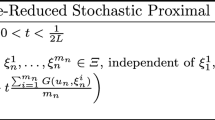Abstract
The recently developed mathematical framework of Hilbert resolution space valued random processes is used to formulate and solve an abstract quadratic optimization problem. By particularizing the description of the operators appearing in the statement and solution formula of the problem, one rediscovers and generalizes most of the classical estimation and control theory problem statements and results. These include, among others, the Wiener smoothing prediction filter, the Kalman regulator, the Kalman-Bucy filter, the stochastic control separation principle and the more recent Youla-Jabr-Bongiorno optimal servo problem solution.
Similar content being viewed by others
References
B. D. O. Anderson, J. B. Moore,Linear Optimal Control, Prentice Hall, Englewood Cliffs, New Jersey, 1971.
A. V. Balakrishnan, Stochastic Filtering and Control of Linear Systems: A General Theory,Control Theory of Systems Governed by Partial Differential Equations, Academic Press, New York, 1977.
A. V. Balakrishnan,Applied Functional Analysis, Springer-Verlag, New York, 1976.
A. V. Balakrishnan, J. L. Lions, State Estimation for Infinite Dimensional Systems,J. Computer and Systems Sciences, 1, 391–403, (1967).
J. F. Barrett, Construction of Linear Quadratic Regulators Using Spectral Factorization and the Return Difference Matrix,Techn. Report CN/75/4, The University of Cambridge, May 1975.
H. W. Bode, C. E. Shannon, A Simplified Derivation of Linear Least Square Smoothing and Prediction Theory,Proc. IRE, 38, 417–425, 1950.
S. S. L. Chang,Synthesis of Optimum Control Systems, McGraw-Hill, New York, 1961.
R. F. Curtain, Estimation and Stochastic Control for Linear Infinite Dimensional Systems,Probability Analysis and Related Topics, Vol 1, (Bhraucha-Reid Editor, Academic Press, New York (to appear).
R. M. DeSantis, Causality Theory in Systems Analysis,IEEE Proc., 64, 36–44, 1976.
R. M. DeSantis, W. A. Porter, On the Generalization of the Volterra Principle of Inversion,J. Appl. Math. Anal., 48, 743–748, 1974.
R. M. DeSantis, Causality Structure of Engineering Systems,SEL Tech. Rep. 67, The University of Michigan, Ann Arbor, Michigan, Sept. 1972.
R. M. DeSantis, W. A. Porter, On Time Related Properties of Non-linear Systems,SIAM J. Appl. Math., 24, 188–206, 1973.
R. M. DeSantis, On a Generalized Volterra Equation in Hilbert Space,Proc. AMS, 38, 563–570, 1973.
D. Duttweiler, Reproducing Kernel Hilbert Space Techniques for Detection and Estimation Problems,Ph.D. Thesis, Stanford Univ., Stanford, 1970.
P. Falb, Infinite Dimensional Filtering: The Kalman-Bucy Filter in Hilbert Space,Information and Control, 11, 102–137, 1967.
I. Z. Gohberg, M. G. Krein,Theory of Volterra Operators in Hilbert Space and Applications, (translation), Amer. Math. Soc., Providence, 1969.
R. E. Kalman, Contributions to the Theory of Optimal Control,Bol. Soc. Math. Mexicana, 5, 102–119, 1960.
R. E. Kalman, R. S. Bucy, New Results in Linear Filtering and Prediction Theory, Trans. ASME, Series D.,J. of Basic Engrg., 82, 95–100, 1961.
T. Kailath, D. Duttweiler, A RKHS Approach to Detection and Estimation Problems—Part III: Generalized Innovations Representations and a Likelihood Ratio Formula,IEEE Trans. on Infor. Theory, IT-18, 730–745, 1972.
T. Kailath, An Innovation Approach to Least-Squares Estimation Parts I and II,IEEE Trans. on Auto. Contr., Vol. AC-13, No. 6, 646–660, 1968.
H. Kwakernaak, R. Sivan,Linear Optimal Control Systems, Wiley-Interscience, New York, 1972.
R. J. Leake, Duality Condition Established in the Frequency Domain,IEEE Trans. Infor. Theory, (correspondence), IT-11, 461, 1965.
A. G. J. MacFarlane, Return Difference Matrix Properties for Optimal Stationary Kalman-Bucy Filter,Proc. IEEE, 118, 373–376, 1971.
G. C. Newton, L. A. Gould, J. F. Kaiser,Analytical Design of Linear Feedback Controls, Wiley, New York, 1957.
W. A. Porter, A Basic Optimization Problem in Linear System,Math. Sys. Theory, 5, 20–44, 1971.
W. A. Porter,Modern Foundations of Systems Theory, MacMillian, New York, 1966.
W. A. Porter, C. L. Zahm, Basic Concepts in System Theory,SEL Tch. Rep. 33, The University of Michigan, Ann Arbor, Michigan, 1969.
W. A. Porter, Some Circuit Theory Concepts Revisited,Inter. J. of Contr., 12, 433–448, 1970.
W. A. Porter, Nonlinear Systems in Hilbert Space,Inter. J. of Contr., 13, 593–602, 1971.
R. Saeks, The Factorization Problem—A Survey,IEEE Proc., 64, 90–95, 1976.
R. Saeks,Resolution Space Operators and Systems, Springer-Verlag, New York, 1973.
R. Saeks, Reproducing Kernel Resolution Space and Its Applications,J. of the Franklin Institute, 302, 331–355, 1976.
R. Saeks, Causal Factorization, Shift Operators and the Spectral Multiplicity Function,Vector and Operator Valued Measures, (D. H. Tucker, Ed.), Academic Press, New York, 319–335, 1973.
R. Saeks, Causality in Hilbert Space,SIAM Rev., 12, 357–383, 1970.
R. Saeks, State in Hilbert Space,SIAM Rev., 15, 283–308, 1973.
R. Saeks, Fourier Analysis in Hilbert Space,SIAM Rev., 15, 604–638, 1973.
A. Schumitzky, Unpublished Notes, Univ. of Southern California, 1978.
A. Schumitzky, On the Equivalence Between Matrix Riccati Equations and Fredholm Resolvents,J. Comp. and Sys. Sciences, 2, 76–87, 1968.
W. K. Schnure, System Identification: A State Approach,SEL Tech. Rep. 80, Univ. of Michigan, Ann Arbor, Michigan, 1974.
M. Steinberger, A. Schumitzky, and L. Silverman, Optimal Causal Feedback Control of Linear Infinite-Dimensional Systems,SIAM J. on Control, (to appear).
L. J. Tung, R. Saeks, Wiener-Hopf Techniques in Resolution Space,Proc. of the 2nd OTNS International Symposium, Texas Tech University, Aug. 1977.
L. J. Tung, Random Variables, Wiener-Hopf Filtering and Control Formulated in Abstract Space,Ph.D. Thesis, Texas Tech Univ., Lubbock, Texas, July 1977.
N. Wiener,Extrapolation, Interpolation and Smoothing of Stationary Time Series, MIT Press, Cambridge, 1966.
W. M. Wonham, “On the Separation Theorem of Stochastic Control,”SIAM J. Control, 6, 312–326, 1968.
D. C. Youla, H. A. Jabr, J. J. Bongiorno, Modern Wiener-Hopf Design of Optimal Controllers, Parts I and II,IEEE Trans. on Automatic Control, AC-21, 3–13, 319–337, 1976.
Author information
Authors and Affiliations
Additional information
This research has been supported in part by U.S. Air Force Office of Scientific Research Grant 74-2631 and Canadian Research Council Grant CNRC-8244.
Rights and permissions
About this article
Cite this article
DeSantis, R.M., Saeks, R. & Tung, L.J. Basic optimal estimation and control problems in Hilbert space. Math. Systems Theory 12, 175–203 (1978). https://doi.org/10.1007/BF01776572
Received:
Accepted:
Issue Date:
DOI: https://doi.org/10.1007/BF01776572




